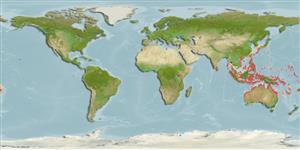Common names from other countries
Environment: milieu / climate zone / depth range / distribution range
Ökologie
seewasser; süßwasser; brackwasser demersal; amphidrom (Ref. 59012); tiefenbereich 0 - 5 m (Ref. 86942). Tropical; 22°C - 28°C (Ref. 12468)
Indo-West Pacific: Philippines and Indonesia (also Sunda Is.) through to Micronesia, southern Japan, Papua New Guinea, the Solomon Islands, Vanuatu, Fiji and New Caledonia.
Size / Gewicht / Alter
Maturity: Lm ? range ? - ? cm
Max length : 14.0 cm SL Männchen/unbestimmt; (Ref. 48637)
Rückenflossenstacheln (insgesamt) : 7; Rückenflossenweichstrahlen (insgesamt) : 8; Afterflossenstacheln: 1; Afterflossenweichstrahlen: 8 - 9; Wirbelzahl: 25. This species is distinguished by the followingcharacters: no scales between eyes and orbital ridges, IOS 0/1-3/0; jaws reaching back to below front part of eye; absence of auxiliary scales on body; body depth at anal fin origin 13-17% SL (Ref. 130228).
This species is reported to occur in many coastal streams in brackish to freshwaters and estuaries over substrates of mud, sandy mud or leaf litter and is often observed clinging upside down under dead wood, eyes facing downwards. An ambush hunter, feeding mainly on small fish and crustaceans (shrimps (Atyidae), prawns (Palaemonidae)) (Ref. 130228). .Usually found in brackish mangrove areas and in creeks and rivers, sometimes well upstream (Ref. 2847), 48637).
Life cycle and mating behavior
Maturities | Fortpflanzung | Spawnings | Egg(s) | Fecundities | Larven
Keith, P. and M.I. Mennesson, 2023. Review of Butis (Teleostei: Butidae) from Indo-Pacific islands with description of three new species. Cybium 47(4):431-466. (Ref. 130228)
IUCN Rote Liste Status (Ref. 130435)
CITES (Ref. 128078)
Not Evaluated
Bedrohung für Menschen
Harmless
Nutzung durch Menschen
Fischereien: kommerziell; Aquarium: Kommerziell
Tools
Zusatzinformationen
Download XML
Internet Quellen
Estimates based on models
Preferred temperature (Ref.
115969): 24.9 - 29.3, mean 28.6 (based on 2274 cells).
Phylogenetic diversity index (Ref.
82804): PD
50 = 0.5156 [Uniqueness, from 0.5 = low to 2.0 = high].
Bayesian length-weight: a=0.00617 (0.00312 - 0.01219), b=3.01 (2.83 - 3.19), in cm Total Length, based on LWR estimates for this species & (Sub)family-body (Ref.
93245).
Trophic level (Ref.
69278): 4.2 ±0.7 se; based on size and trophs of closest relatives
Widerstandsfähigkeit (Ref.
120179): hoch, Verdopplung der Population dauert weniger als 15 Monate. (Preliminary K or Fecundity.).
Fishing Vulnerability (Ref.
59153): Low vulnerability (10 of 100).
